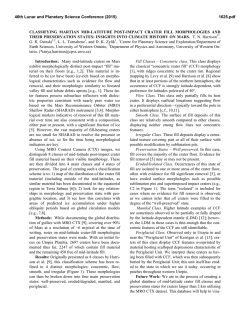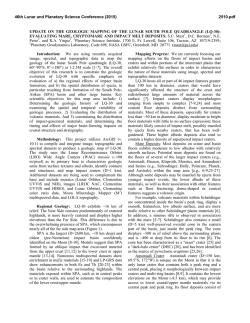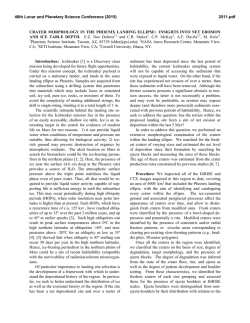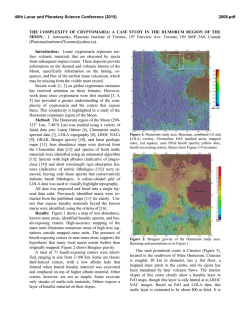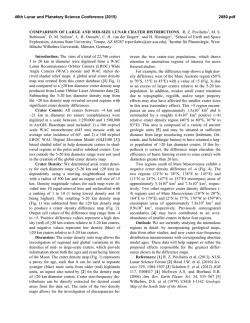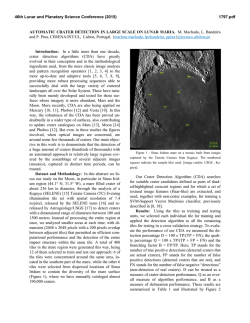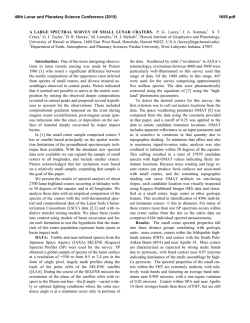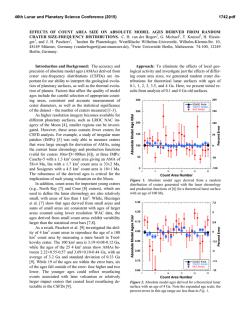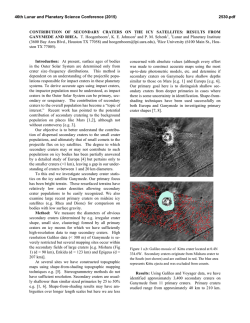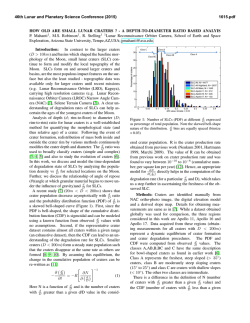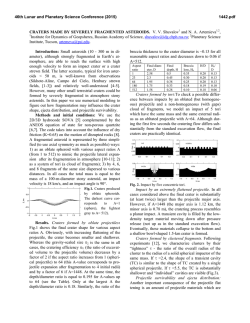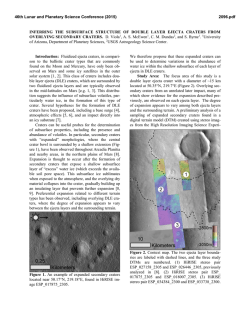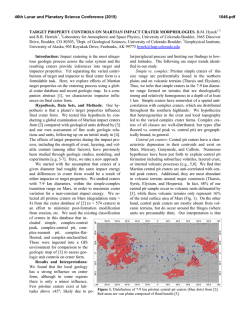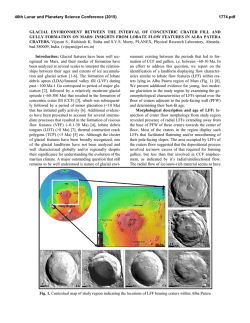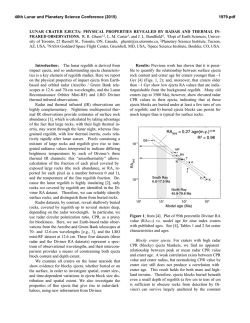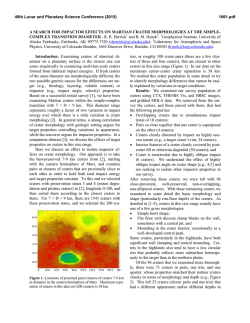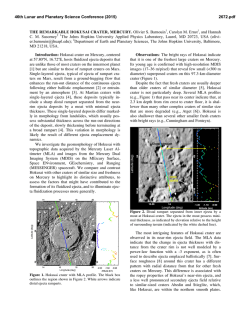
Has the Lunar Impact Flux Rate Changed in the Past Billion Years?
46th Lunar and Planetary Science Conference (2015) 2331.pdf HAS THE LUNAR IMPACT FLUX RATE CHANGED IN THE PAST BILLION YEARS? S. Mazrouei1, R. R. Ghent1, 2, W. F. Bottke3, 1Department of Earth Sciences, University of Toronto, Toronto, ON, Canada. 2Planetary Science Institute, Tucson, AZ, USA. 3Southwest Research Institute and the Institute for the Science of Exploration Targets (ISET), Boulder, CO, USA Introduction: Constraints on the recent lunar cratering rate are elusive, and yet provide vitally important clues to the ages and geological history of young features on the Moon. Here, we investigate the Copernican-era impact flux using a new method for determining crater ages derived from the Lunar Reconnaissance Orbiter (LRO) Diviner rock abundance dataset [1, 2]. The study of the lunar impact flux is important to planetary science because it provides a means of dating planetary surfaces. This, in turn, provides a means of measuring rates of geological processes, and ultimately, of understanding the evolution of the Earth and other bodies in our Solar System. Previously, crater counting methods and geological maps have been used to determine the ages of lunar terrains and individual features. Those methods, however, are (i) extremely time consuming, (ii) are limited by image quality, image availability, and the need to identify small craters over datable regions, and (iii) are subject to systematic errors derived from uncertainty in the crater production function and small number statistics. Therefore, it would be useful to have another way to explore this challenging problem. It has recently been shown that the rockiness of large craters’ ejecta, derived from the LRO Diviner thermal radiometer data [2], provides an alternative method for estimating the ages of craters younger than roughly one billion years old (Copernican craters) [1]. Young surfaces have abundant fresh, sharp rocks, while older terrains have lower rock abundances, with both small impacts and thermal cracking producing rock demolition over time [3]. This rate was quantified in [1] using a calibration derived from nine craters with published model ages, providing an alternative chronometer that is not subject to the constraints of traditional crater counting methods using visiblewavelength images. The results of [1] show that in essence, only craters younger than ~1 Ga have ejecta blankets with rock abundance values that are higher than the background regolith. This broadly corresponds to the Copernican era [4]. We use this correspondence to investigate the statistics of subgroups of this crater population. Methodology: The Diviner rock abundance dataset expresses the areal fraction of each Diviner pixel occupied by exposed rocks large enough to remain warm through the lunar night [2]. The rock abundance value for the background regolith is generally around 0.005, which implies that 0.5% of each pixel area is covered by exposed rocks. On the other hand the rocky ejecta of the fresher craters show significant number of Diviner pixels with high rock abundance values. Here, we calculate size-frequency distributions (SFD) for all craters larger than 5 km in diameter between 80ºS and 80ºN with elevated Diviner rock abundances, and examine the results for variations from previously reported Copernican SFDs. We also apply the rock abundance - crater age relationship derived in [1]: RA95/5=0.27×(age [m.y.])-0.46 (1) where RA95/5 is the 95th percentile value of the rock abundance for a given crater, to calculate ages for our study craters, with error bars on the resulting ages corresponding to 95% confidence belts on the regression in Equation (1). In calculating RA95/5, we exclude all terrain within topographic crater rims, large melt deposits, and obvious small craters that have newly excavated buried rocks. Using these values, we calculate SFDs for subgroups of craters in various age bins, and analyze the results for variations over time. Results: Figure 1 shows an example of a rocky crater (Jackson), which has a published model age of 147 ± 3.8 Ma [5]. Figure 1 shows a typical rocky ejecta blanket with rock abundance values exceeding 1%; very young craters’ ejecta are characterized by values up to >10%. Figure 1: Rock abundance map of Jackson Crater (22.4° N, 163.1° W, ~17.4km diameter). 46th Lunar and Planetary Science Conference (2015) 2331.pdf Figure 2 shows that for older craters such as Joule crater, with a published age of 4.0 ± 0.1 Ga [6], rock abundance values are low and indistinguishable from the background regolith (values on the order of 0.005). Figure 2: Rock abundance map of Joule Crater (27.3° N, 144.2° W, ~96km diameter). We identify 580 craters larger than 5 km in diameter with rocky ejecta. The SFD for the entire population of rocky craters (Fig. 3) is largely consistent with that calculated previously for the population of Copernican craters [4, 7], identified as such on the basis of geologic mapping and crater rays. Eight craters larger than 20 km in diameter on the farside, identified as Copernican by [7], do not show high rock abundance in their ejecta. These craters are therefore excluded from our dataset. An example is Coriolis Y, which was indicated by [7] as having an uncertain identification of bright rays. On the contrary, we have defined Joule T crater as Copernican, which showed uncertain bright rays for [7]. On the nearside, there are 15 craters previously identified as Copernican by [4] that have been excluded from our dataset due to lack of blocky ejecta, such as Rutherford crater. Figure 3: Size-frequency distribution comparison: Copernican craters shown in red [7], versus identified craters with distinct rock abundance in their ejecta, shown in blue, and the Neukum 2001 Production Function [8]. Craters identified as younger than 100 my. in this study are shown in green. Current Work: As outlined above, we are currently analyzing sub-populations of Copernican craters with ages calculated using the regression of [1]. We have already identified deviations from the Neukum production function [8], though our work is preliminary. In addition to the SFD calculated for our entire Copernican population, Figure 3 also shows the SFD for craters with ages calculated as above at <100 my. The deviation in slope from that of the cumulative curve for crater diameters <20 km demonstrates a population of small craters in excess of that predicted by the function of [8]. This work, and other results that will be shown in our talk, show that the impact flux has varied substantially over the past 1 Gyr, in contrast to standard assumptions of a constant impact flux over the last 3 Gyr. References: [1] Ghent, R.R., et al. (2014), Geology 42, N10. [2] Bandfield, J.L., et al. (2011), Journal of Geophysical Research 116: E12. [3] Delbo, M., et al. (2014), Nature, 508. [4] Wilhelms, D. E., et al. (1978), Planetary Science Conference 9, 3735-3762. [5] van der Bogert, C. H., et al. (2010), LPSC XLI, Abstract #2165. [6] Kirchoff, M.R., et al. (2013), Icarus 225, 325-241. [7] McEwen, A.S., et al. (1997), Journal of Geophysical Research 102: E4. [8] Ivanov, B.A., et al. (2002), Asteroids III, 89-101.
© Copyright 2025

